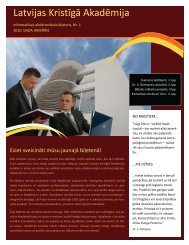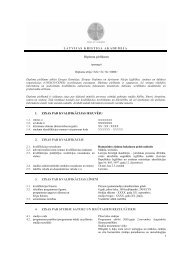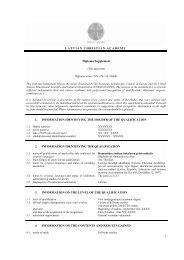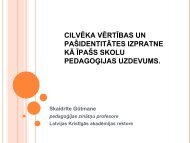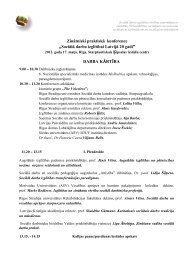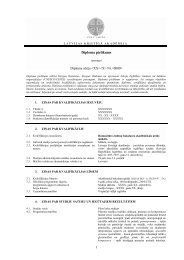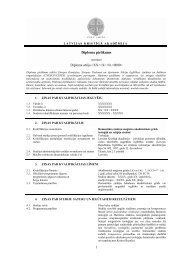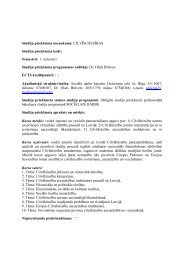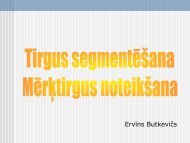SWOT analysis for study year 2008/2009:
SWOT analysis for study year 2008/2009:
SWOT analysis for study year 2008/2009:
Create successful ePaper yourself
Turn your PDF publications into a flip-book with our unique Google optimized e-Paper software.
Study programme “Bible Art” of Latvian Christian Academy<br />
<strong>SWOT</strong> <strong>analysis</strong> <strong>for</strong> <strong>study</strong> <strong>year</strong> <strong>2008</strong>/<strong>2009</strong>:<br />
Signs of strengths<br />
Signs of weaknesses<br />
• Connection to traditional Christian<br />
denominations in Latvia<br />
• Lack of local sacred artists<br />
• Greater need <strong>for</strong> visits to monasteries and<br />
• Good contacts with Israel, Sinai monastery<br />
of St. Catherine (Egypt), Romania – good<br />
examples of sacred orientation in arts<br />
ancient-Orthodox church centers<br />
• No connection with artists who are masters<br />
in Church mosaics<br />
• Students original research on the field of<br />
sacred arts & theory<br />
• Great need <strong>for</strong> teacher in calligraphy<br />
• More focus on denominational research<br />
• Small <strong>study</strong> groups<br />
• More intensive investment in the<br />
• Involvement of Church leaders and<br />
graduates in annual evaluation of <strong>study</strong><br />
results<br />
development of the master Programme in<br />
Sacred Art<br />
• Well motivated and professionally<br />
challenging academic staff/team<br />
<strong>SWOT</strong> <strong>analysis</strong> <strong>for</strong> <strong>study</strong> <strong>year</strong> <strong>2009</strong>/2010:<br />
Signs of strengths<br />
Signs of weaknesses<br />
• Good involvement of teachers / students<br />
research and international projects:<br />
corporative high level responsibility to<br />
reach quality goals<br />
• Part of the students should be spiritually<br />
better motivated<br />
• More strongly stressed students’<br />
independent work<br />
• Exhibitions in EC project “Intercultural<br />
Dialogue: Sacred Elements of European<br />
National Art” were well received by<br />
audience<br />
• Reduction of graphic in curricula didn’t<br />
give the real results<br />
• Time consuming qualification growth of<br />
young academic staff<br />
• Carefully organized international / local<br />
teacher team on the unified plat<strong>for</strong>m <strong>for</strong><br />
the development of sacred art<br />
• Sociological questionnaires <strong>for</strong> the second<br />
semester were not done in time<br />
• Strong attention must be paid to young<br />
colleagues – to their academic growth<br />
(exhibitions, publications, etc.)<br />
The latest <strong>SWOT</strong> <strong>analysis</strong> <strong>for</strong> 2010/2011 as follows:<br />
Signs of strengths<br />
1. Study process:<br />
• Study programme requested by Churches of traditional<br />
denominations in Latvia and other countries;<br />
• Good cooperation with specialists from Latvian<br />
Academy of Arts offering mutual enrichment: LAA<br />
provides education <strong>for</strong> artists with secular orientation<br />
whereas LChrA – specialists in sacred art;<br />
• Well-established network of academic cooperation with<br />
those <strong>for</strong>eign specialists where traditions of ancient<br />
Christian art (both Eastern and Western) dominate;<br />
• Good contacts with Israel by participation in<br />
archaeological digs – good basis <strong>for</strong> further research,<br />
studies and inspiration;<br />
• Facilities at the Academy are created with focus on<br />
creation of works of sacred art;<br />
Signs of weaknesses<br />
• Limited opportunities to<br />
involve local sacred artists,<br />
subsequently specialists must<br />
be produced by the Academy<br />
which is time consuming;<br />
• Students are subject to rather<br />
tense and loaded <strong>study</strong><br />
process because the<br />
programme is<br />
interdisciplinary (theology +<br />
art subjects + courses in art<br />
history and theory);<br />
• Time consuming qualification<br />
growth of young academic<br />
staff ;
Signs of strengths<br />
• Fresh new artists’ workshops and equipment which<br />
serves to acquisition of the set aims;<br />
• Academic library is qualitative and corresponds to<br />
needs of the Study programme.<br />
2. Students:<br />
• Students involved in the programme carry out original<br />
research in the field of sacred art and theory which is<br />
furthered in Master and Doctoral studies;<br />
• Students are involved in preservation of traditional<br />
values in art, they strive <strong>for</strong> high level in drawing and<br />
painting – skills which are lost in many Western<br />
universities;<br />
• Exhibitions of sacred art organized by students are well<br />
received in Latvian churches and recognized by both<br />
clergy and other attendants;<br />
• Individual approach to every single student;<br />
• Small <strong>study</strong> groups;<br />
• Students may choose the <strong>for</strong>m of studies which suits<br />
them best: full time studies or part time studies;<br />
• Involvement of students and graduates in annual<br />
evaluation and improvement of the Study programme.<br />
2. Academic staff<br />
• Well-motivated and professionally challenging;<br />
• Internationally well received scientific consultants who<br />
work in tandems with young pedagogues.<br />
Prospects of development<br />
• Competitiveness of facilities <strong>for</strong> workshops and<br />
auditoriums and material provision on European level;<br />
• Students catch the need <strong>for</strong> education and studies of<br />
sacred art in the free marker society; their positive<br />
motivation;<br />
• Carefully shaped and developed interuniversities<br />
network <strong>for</strong> exchange of students and lecturers;<br />
• Interdenominational, Church-oriented research work<br />
done by students should be promoted;<br />
• Involvement of academic staff and students of the<br />
Study programme in European projects <strong>for</strong> culture and<br />
youth involvement based on principles of Christian<br />
democracy;<br />
• Investments of material provision in the development of<br />
the Master programme in Theology in order to educate<br />
specialists of Humanitarian culture in research in the<br />
field of sacred art;<br />
• Investment in the development of the Master<br />
programme “Bible Art” (prepared <strong>for</strong> licensing)<br />
• Regular involvement of both students and academic<br />
staff in various international and art projects.<br />
• Well-tuned and compact academic staff.<br />
Signs of weaknesses<br />
• Uneven <strong>for</strong>mer education of<br />
students in art related topics;<br />
• Insufficient system of<br />
workshops in monasteries<br />
since they accept only those<br />
students who belong to the<br />
same denomination.<br />
Threats<br />
• Insufficient financial means of<br />
students reflecting growing<br />
inflation in Latvia;<br />
• Difficulties to involve<br />
specialists in sacred art in the<br />
implementation of the <strong>study</strong><br />
process whose mission is to<br />
combine their academic<br />
qualification with<br />
prerequisites of sacramental<br />
thinking rooted in Ancient<br />
Church (both eastern and<br />
Western) praxis.




